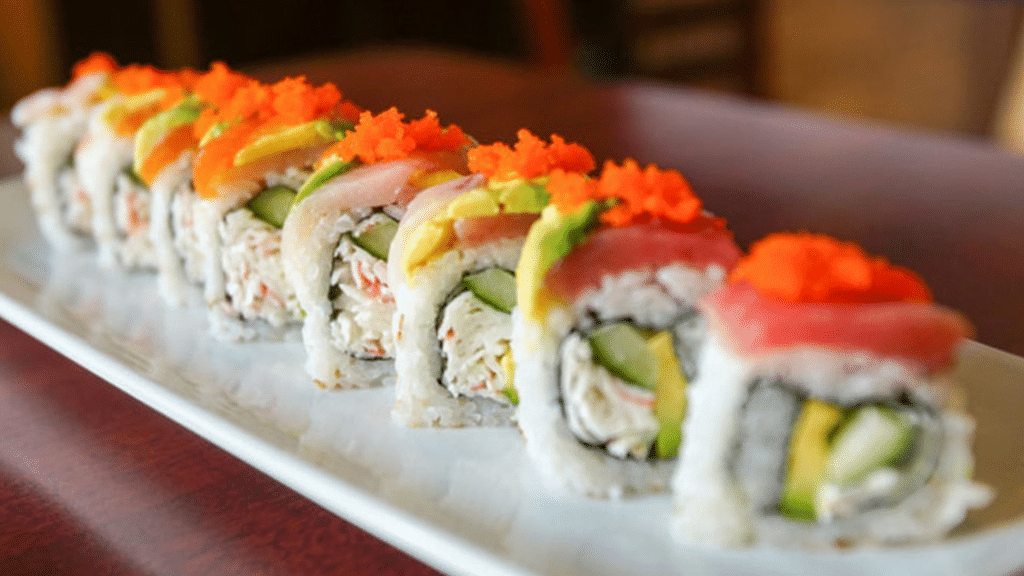Delicious and Simple Kosher Sushi Salad Recipe
Written By James Morgan
Welcome to our comprehensive guide to creating the ultimate kosher sushi salad recipe. Packing a punch of umami flavors and ensuring it adheres to kosher dietary rules, this dish offers a fresh new way to enjoy sushi's quintessential flavors without the hassle of rolling and wrapping.

Introduction to Kosher Sushi Salad
The kosher sushi salad recipe amalgamates Asian culinary traditions with kosher guidelines, providing a meal that's both flavorful and culturally significant. It simplifies traditional sushi into a deconstructed salad, making it accessible and inviting for everyone to try, especially those who keep kosher. Eating healthy can be challenging, but with fresh raw veggies, satisfying proteins, and nourishing greens, this meal checks all the boxes.

Ingredients
The key to mastering this kosher sushi salad recipe is having fresh, high-quality ingredients. Let's go step-by-step to gather everything you need.
- 2 cups sushi rice
- 3 cups fresh mixed greens
- 1 cup julienned carrots
- 1 avocado, diced
- 1 English cucumber, sliced
- 1/2 cup nori strips
- 1 lb sushi-grade salmon or alternative fish options
- 4 tbsp soy sauce, tamari for gluten-free
- 2 tbsp rice vinegar
- 1 tbsp sesame oil
- 1 tbsp pickled ginger
- 2 tbsp toasted sesame seeds
- 2 green onions, finely chopped
Tools You'll Need
To make your cooking experience seamless and enjoyable, consider these kitchen tools: Rice Cooker, Sushi Knife, Cutting Board, Strainer, Sushi Making Kit.

Step-By-Step Instructions
Step 1: Preparing the Sushi Rice
Start by thoroughly rinsing the sushi rice in a strainer to remove excess starch. This step ensures a clean cook and prevents the rice from turning gummy. Transfer the rinsed rice to your rice cooker. Add water based on the rice cooker's instructions, usually around a 1:1.5 ratio of rice to water. Cook until rice is tender, then let it cool to room temperature.
Step 2: Preparing the Vegetables
While your rice is cooking, wash and prepare your vegetables. Julienne the carrots, dice the avocado, and slice the cucumber. Ensure all ingredients are bite-sized for easy scooping with chopsticks or fork. Freshness is paramount, so try to use organic produce.
Step 3: Slicing the Fish
For the sushi-grade salmon or any fish of your choice, use a sushi knife for precision. Slice the fish thinly and evenly to ensure perfect portions in every bite. Given the raw nature of sushi, it's crucial to ensure the fish is ultra-fresh and handled with proper hygiene.
Step 4: Assembling the Salad
In a large mixing bowl, combine your room-temperature rice, mixed greens, julienned carrots, diced avocado, sliced cucumber, nori strips, and sliced fish. Gently toss to allow all ingredients to intermingle flavors. This deconstructed approach keeps the dish visually appealing and all flavors distinguishable yet harmonious.
Step 5: Dressing It Up
For the dressing, mix the soy sauce, rice vinegar, sesame oil, and pickled ginger in a separate small bowl. Drizzle this mixture over the tossed salad, ensuring an even coating for maximum flavor distribution. Sprinkle with toasted sesame seeds and finely chopped green onions for added crunch and a pop of color.

Tips and Variations
Vegetarian Option
To make this dish vegetarian or vegan, substitute the sushi-grade fish with tofu or tempeh. Firm tofu, when marinated well, provides a delightful textural contrast and absorbs the flavors beautifully. Tempeh's nutty flavor can offer a unique twist to the traditional sushi salad.
Make It Spicy
If you prefer a bit of heat, consider adding a dash of Sriracha or wasabi paste to the dressing. This kick will not only elevate the flavor profile but also provide a pleasing contrast against the creamy avocado and refreshing cucumber.
Alternative Grains
For a gluten-free option or just to mix things up, you could use quinoa or brown rice instead of sushi rice. These grains hold dressings well and provide a slightly different texture, but rest assured, they will still win your palate over.
Health Benefits
Not only is this kosher sushi salad recipe delicious, but it's also packed with nutritional benefits. The combination of fresh vegetables, healthy fats from avocado, and lean protein from sushi-grade fish creates a balanced meal that's light yet satisfying. Incorporating seaweed in the form of nori also provides a dose of essential minerals and vitamins often lacking in standard diets.
Conclusion
This kosher sushi salad recipe is versatile, healthy, and perfect for those who love sushi but want an easier way to enjoy it. Whether you're keeping kosher or just looking to try something new, this dish promises to be a hit at any meal. Be sure to check out our Squash Casserole Recipe and our Chicken Thighs Recipe for more culinary inspirations. Enjoy your meal!
Cookware Cleaner: For the best results, be sure to clean your cookware meticulously after making your kosher sushi salad. This Cookware Cleaner and Cutting Board Oil ensure longevity and hygiene.
As an Amazon Associate, I earn from qualifying purchases.
FAQs
Q: Can I make this kosher sushi salad recipe ahead of time?
A: Yes, you can prepare the components ahead, but it's best to assemble the salad just before serving to maintain its freshness.
Q: Is this recipe gluten-free?
A: The recipe can be made gluten-free by using tamari instead of soy sauce and ensuring all other ingredients are certified gluten-free.
Q: Can I use different types of fish?
A: Absolutely! Just ensure it's sushi-grade to guarantee safety when consuming raw fish.



